The Ariya represents Nissan’s second generation of electric vehicles, following the Leaf in 2010. It took about ten years for the Japanese automaker to introduce a new high-volume, 100% electric model.
We already know the Nissan Ariya well, having test-driven its two-wheel-drive version with a single 218-hp electric motor in Sweden. This variant is paired with a 63 kWh battery (usable capacity, 66 kWh nominal value), providing 403 km (250 miles) of WLTP-rated range.
While this is an interesting offering, Nissan now has a better option: more power, more range, and more driving pleasure with the Nissan Ariya e-4ORCE. This model features two electric motors for a combined output of 306 hp and 600 Nm.
While some manufacturers already add sporty badges when a car exceeds 300 hp (like Volkswagen with its ID.4 and ID.5 GTX), Nissan does not necessarily focus on sportiness with the Ariya, but rather on driving enjoyment.
Is the e-4ORCE a better alternative to the “smaller” version we tested a few months ago? We wanted to find out during a test drive starting from Toulouse and taking us all the way to Andorra, in the center of the Pyrenees mountains, still snow-capped at this time of year.
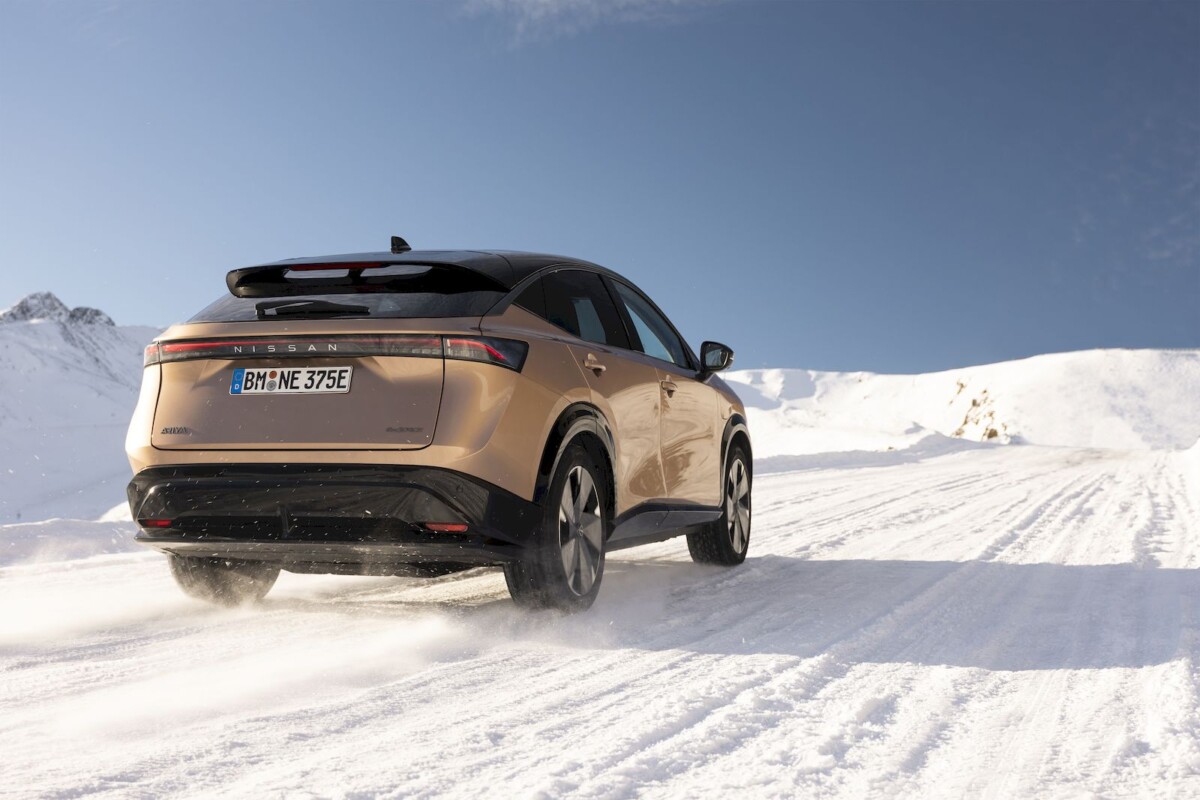
Technical Sheet
| Model | Nissan Ariya (e-4ORCE) |
| Category | SUV |
| Power (horsepower) | 306 hp |
| Power (kW) | 225 kW |
| 0 to 100 km/h | 5.7 seconds |
| Autonomy level | 2 |
| Top speed | 200 km/h |
| Apple CarPlay | Yes |
| Android Auto | Yes |
| Main screen size | 12.3 inches |
| Car side sockets | Type 2 Combo (CCS) |
| Length | 4645 mm |
| Width | 1899 mm |
| Price | $51,150 |
Design
In terms of dimensions, the Nissan Ariya measures 4.60 meters long, 1.85 meters wide (excluding mirrors), and 1.66 meters tall. Its 2.78-meter wheelbase promises ample interior space. The two-wheel-drive version weighs 1,914 kg, while our test model with the larger battery and two electric motors exceeds 2.2 tons, which is quite heavy for a C-segment SUV.
The Nissan Ariya has its own identity that generally breaks away from what we see in other electric SUVs. There are several interesting small details. For example, the grille appears smooth and dark at first glance but actually integrates small patterns that symbolize Kumiko, a Japanese technique for assembling wooden pieces without nails.
Aesthetically, the overall appearance is coherent, but there is a small disappointment: the drag coefficient (Cx) is only 0.29, which is relatively high compared to an Enyaq (0.25) or a Model Y (0.23). However, as with our first test, this did not prevent our Ariya from displaying impressive consumption figures.
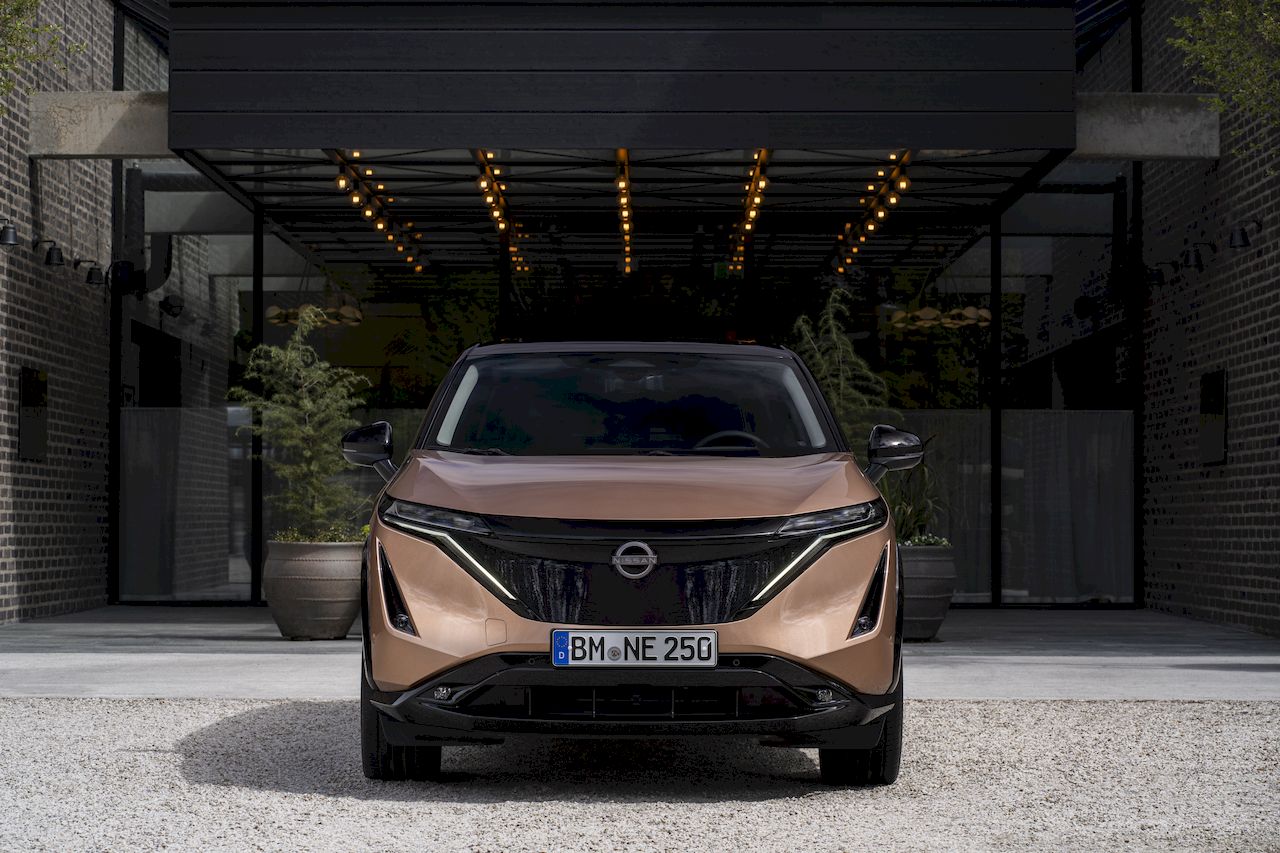
Interior
The interior has a definite “wow” factor. Nissan has done things differently, and even though it opts for minimalism, it is better executed than the interiors of an ID.4 or ID.5.
Regarding materials and finishes, it is quite acceptable for a mainstream model. The faux wood running across the dashboard is visually appealing but less so to the touch. But who will touch the faux wood in their Ariya, you might ask? Nissan has integrated haptic controls at this level. They look aesthetically pleasing, but the haptic feedback is somewhat unpleasant, with a strong vibration that feels a bit cheap.
As for storage, the Nissan Ariya is not particularly good. There is no separation between the driver and passenger, and the floor is perfectly flat. Only the center console adds some flair, a floating and electric center console (available on the high-end “Evolve” trim) that can slide about 15 cm. The problem is that it lacks storage space.
In the rear, the generous wheelbase provides ample legroom, and even the middle-seat passenger will be comfortable. The trunk space is adequate but not extraordinary. Nissan claims a 415-liter capacity for the 4×4 version with a second electric motor in the rear, which is 53 liters less than the two-wheel-drive version. Note that there is no front trunk (frunk) in the vehicle.
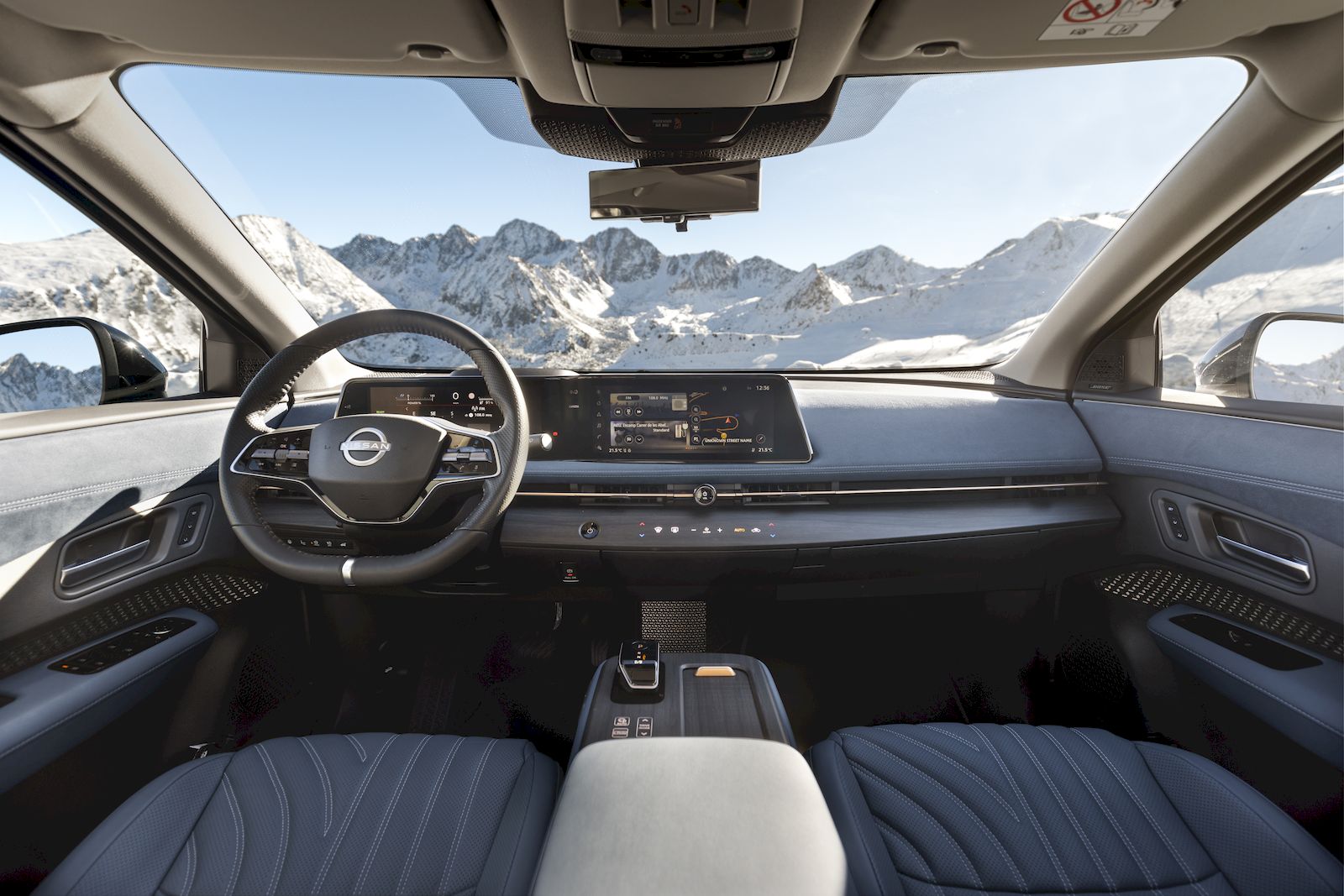
Infotainment
Inside, we find two 12.3-inch screens, one for instrumentation and one for infotainment. In addition, there is a well-designed and easy-to-read head-up display.
The graphics quality of the screens is not quite up to par for a car sold in 2023, which is unfortunate because, in terms of presentation, the Ariya almost looks like a high-end model. The menu ergonomics are a bit complicated, even though the navigation is quite smooth.
There is wireless smartphone charging under the central console armrest and two USB-C ports on the central console. Two additional USB-C ports are available for rear passengers. Wireless Apple CarPlay and wired Android Auto are also available. The NissanConnect Services app allows for remote locking and unlocking of the doors. When paired with Amazon Alexa, these systems work together.
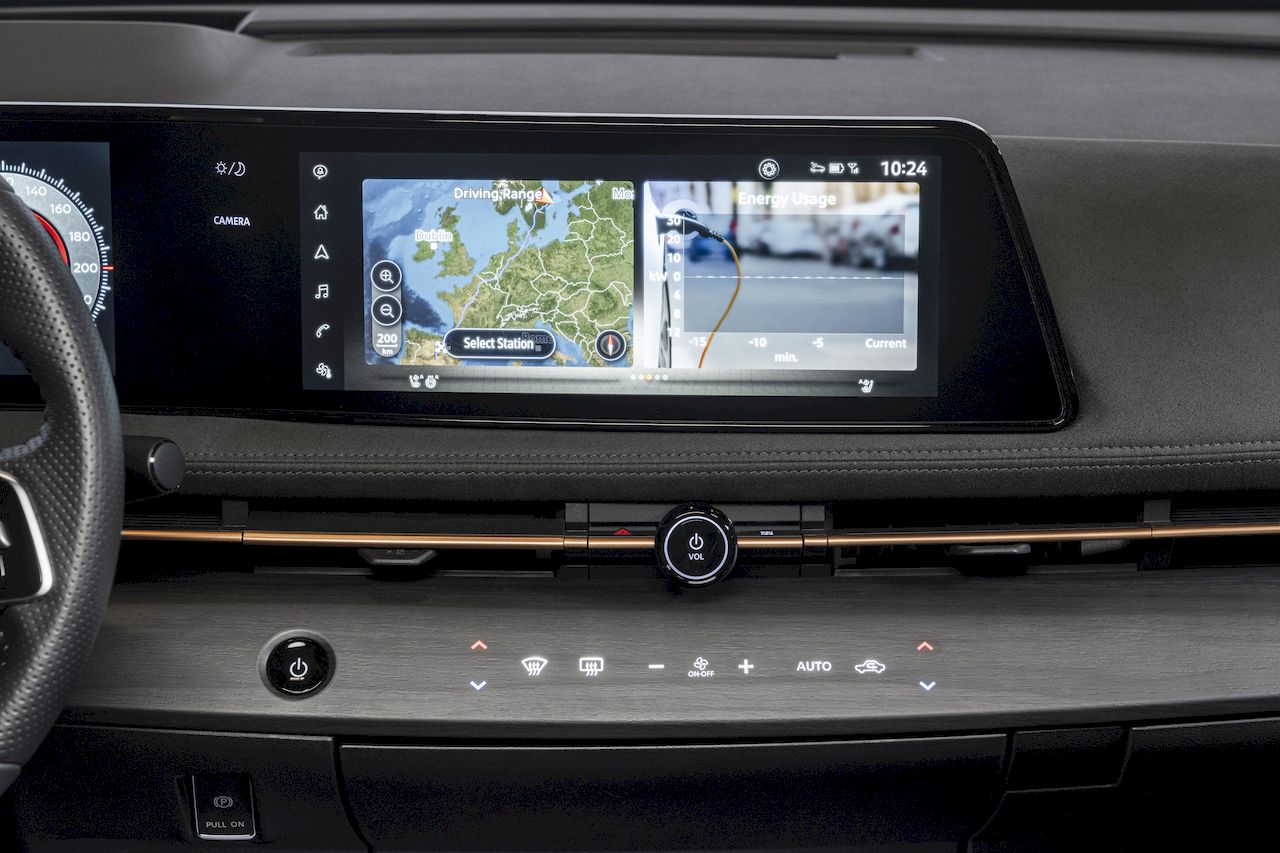
Driving Assistance
The Ariya is equipped with ProPILOT with Navi Link, the latest version of Nissan’s driving assistance system in Europe.
The Ariya comes standard with the Nissan Safety Shield. This package includes a 360° camera, emergency braking with pedestrian, cyclist, and intersection detection, a predictive frontal collision warning system, and lane departure prevention.
We were able to test this system, which is activated via a steering wheel button, and overall it works quite well, with a certain smoothness in the adaptive cruise control that manages the distance to the car ahead of us. This allows for level 2 autonomous driving.
Route Planner
The Ariya features a connected route planner that can calculate the best route by taking into account real-time factors such as road traffic, driving conditions, the availability of charging stations, and the battery’s charge level.
As is often the case with this kind of presentation, we were unable to fully test this system due to time constraints. However, when launching a test drive of about 800 km, the Ariya provided us with the different stages of our journey, including the stops at charging stations and the percentage of charge at each stage and the endpoint.
Driving
Unlike our first test drive which took place around Stockholm, with ideal roads to minimize consumption and many speed cameras, this time the Ariya faced more hilly roads. As we will see, consumption levels are no longer the same, even though our test model is also different.
The Renault Mégane E-Tech, which is based on the same platform, had greatly impressed us during our test. The Ariya shares the same technical foundation but is heavier due to a larger battery pack and a more substantial size.
Our test Ariya is an 87 kWh version (91 kWh in raw data) and features all-wheel drive and two electric motors, giving it a total power output of 306 hp and 600 Nm of torque. The performance is quite good, with a 0 to 100 km/h acceleration time of 5.7 seconds, placing it in the sporty car category.
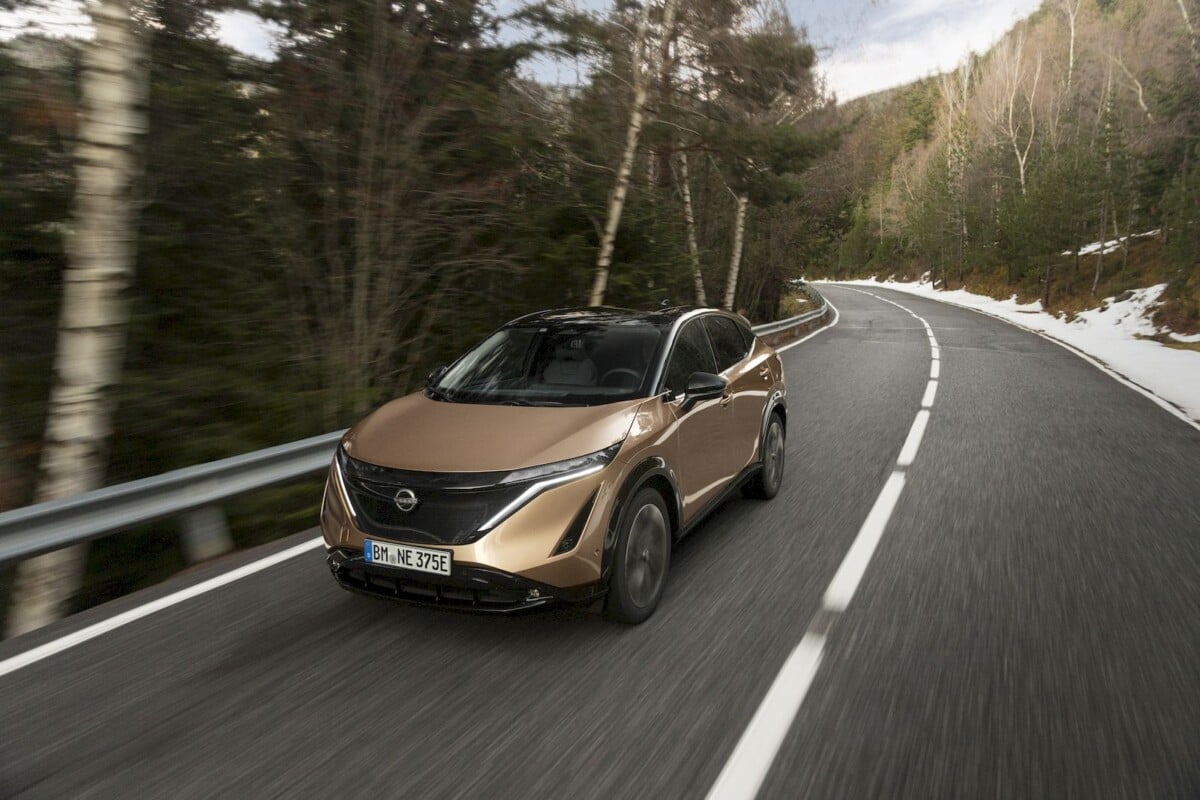
The Ariya offers appreciable comfort despite somewhat firm seating. Comfort remains the primary focus on board, even though the suspension can be slightly stiff on large compressions, such as over a speed bump. In terms of handling, the Ariya performs admirably, with well-contained body movements overall, although the front axle could have benefited from a more pronounced locking mechanism, especially on heavy loads.
We wouldn’t go so far as to say this SUV is sporty, but it has more interesting dynamic attributes compared to Volkswagen’s GTX models. The only downside is the inertia due to its weight, and the steering feels a bit too dull around the center point, but these are minor details.
In terms of consumption, we recorded an average of around 25.1 kWh/100 km, far from the 16.1 kWh/100 km noted during our test of the two-wheel-drive version. There are two explanations for this: the terrain, as we were in a mountainous region with many climbs, and the roads encouraged a slightly more dynamic driving style, without excess, compared to the Swedish routes. Also, let’s not forget that this version is heavier and more powerful.
Nissan claims a combined WLTP consumption of 19.5 kWh/100 km for our version, a figure that is likely achievable with fewer climbs and more urban driving, which we hardly did during our test. The 63 kWh version is rated at 17.6 kWh/100 km.
Nissan has not continued its excellent e-Pedal system, which allowed the vehicle to come to a stop without touching the brake pedal, providing one-pedal driving. It has been replaced by the e-Pedal Step. This amplified regenerative braking system is good, but below 15 km/h, the car coasts, requiring the driver to use the brake for a complete stop. This system can be deactivated.
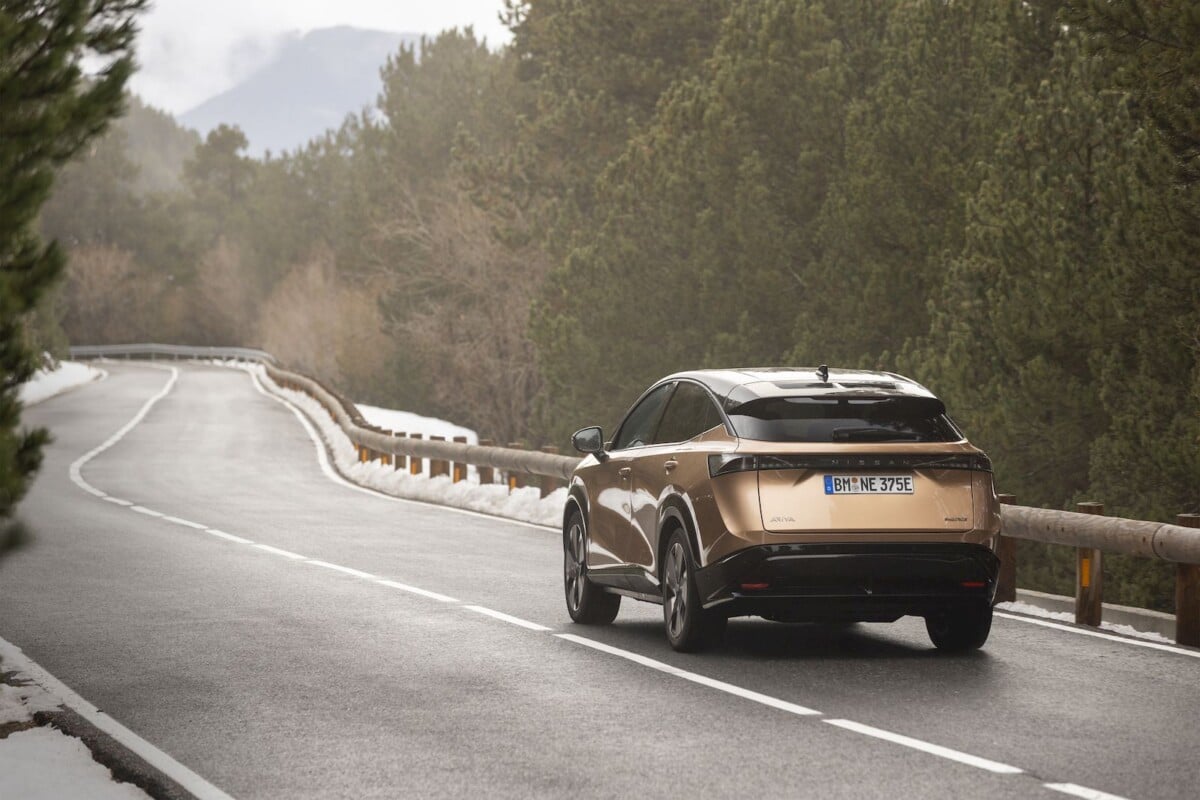
Range, Battery, and Charging
Two battery packs are available. One is 63 kWh (usable capacity, 66 kWh nominal) and the other is 87 kWh (usable capacity, 91 kWh nominal). Our 87 kWh test version claims a WLTP range of 509 km with the top “Evolve” trim. The Ariya’s range with the smaller battery varies around 400 km depending on the trim. Batteries are warrantied for 8 years or 160,000 km.
As usual during these press events, we could not test the charging. We will therefore publish the manufacturer’s announced figures. All versions benefit from a maximum DC charging of 130 kW, a number that may seem “low” when several models now exceed 200 kW.
Nissan justifies this choice primarily to preserve the battery and also because of a constant charging curve that barely weakens up to 80% charge. The 20-80% charge takes 30 minutes, which is average for electric cars.
The car incorporates a manually activated battery pre-conditioning system. This allows the battery to be warmed up when approaching a fast-charging session to achieve the highest possible charging speed. It is also worth noting the presence of a heat pump from the first trim level, which should help prevent significant range loss in cold weather.
Regarding AC charging, power is capped at 7.4 kW as standard, and an additional $1,000 is required for the optional 22 kW onboard charger, available only with our 87 kWh test model. This is good news, as 11 kW onboard chargers are more common in electric cars. Also, forget the CHAdeMO standard with Nissan, as the Ariya uses the new Combo CCS standard.
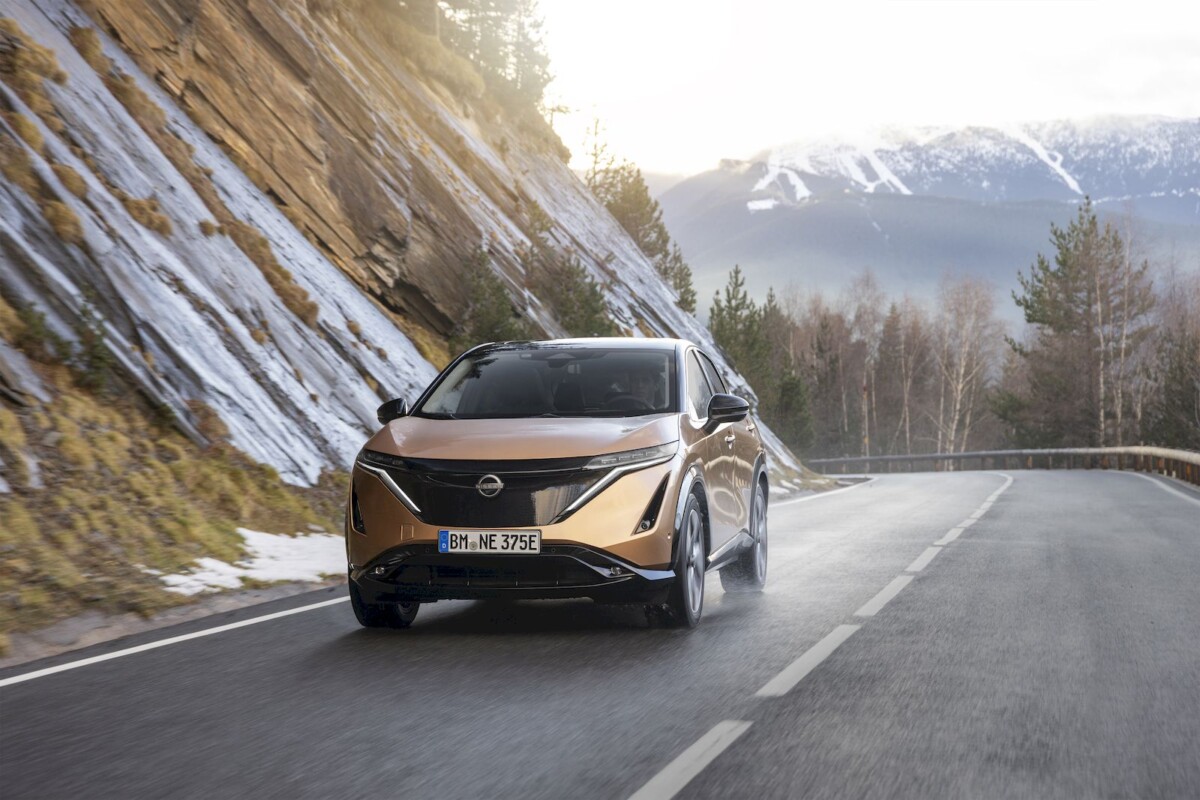
Price, Competition, and Availability
The Nissan Ariya starts at $50,800 in France for the entry-level “Advance” version (which is already well-equipped) with the 63 kWh battery. Our test version “Evolve” e-4orce with the 87 kWh battery starts at $64,400 and also benefits from the panoramic sunroof and tech pack (head-up display, camera rearview mirror, Bose audio system, etc).
It should be noted that prices have already increased significantly in less than a year since the entry-level version was traded for $47,300 not long ago. The Ariya, regardless of the version, is no longer eligible for the ecological bonus in France.
Facing it, we have the Volkswagen ID.4 GTX, available with 77 kWh batteries (499 km of range, 299 hp, starting at $60,650) and the Skoda Enyaq iV RS available with the 77 kWh battery (517 km of range, 299 hp, starting at $62,500).
The Tesla Model Y, without even looking for the Performance version, is more powerful and generally more technological as well. On top of that, it is much cheaper since the “Long Range” version, with two electric motors, starts at $53,990 for a range of 533 km and a power of around 351 hp.
It could also be compared to the Kia EV6 in its 325 hp four-wheel-drive version with its 77.4 kWh battery, which allows for 490 km of range. It trades starting at $57,140. In Hyundai, the Ioniq 5 with its 77.4 kWh battery and 485 km of range trades starting at $64,000. Like the Kia EV6, it has 325 hp and is four-wheel drive.
Editor’s Verdict
Nissan Ariya is generally a very good electric SUV and proves to be much more convincing in terms of dynamism compared to models that claim to be “sporty” like those of the Volkswagen group. The Ariya is a good synthesis between comfort and dynamism, even if the consumptions we have noted are far from giving us a range greater than 500 km as announced.
Nissan Ariya (87 kWh) Pros
- Driving pleasure
- Original enough cabin
- Onboard 22 kW charger (but optional)
Nissan Ariya (87 kWh) Cons
- High prices
- Screen graphics
- Less convincing e-Pedal system than the old one.

